Strategic Management Report: Analyzing Jetstar Airways' Performance
VerifiedAdded on 2022/08/21
|17
|3777
|24
Report
AI Summary
This report provides a comprehensive strategic analysis of Jetstar Airways, a subsidiary of Qantas, focusing on its external and internal environments. The external analysis employs the PEST model to assess political, economic, social, and technological factors influencing Jetstar's operations, along ...
Read More
Contribute Materials
Your contribution can guide someone’s learning journey. Share your
documents today.
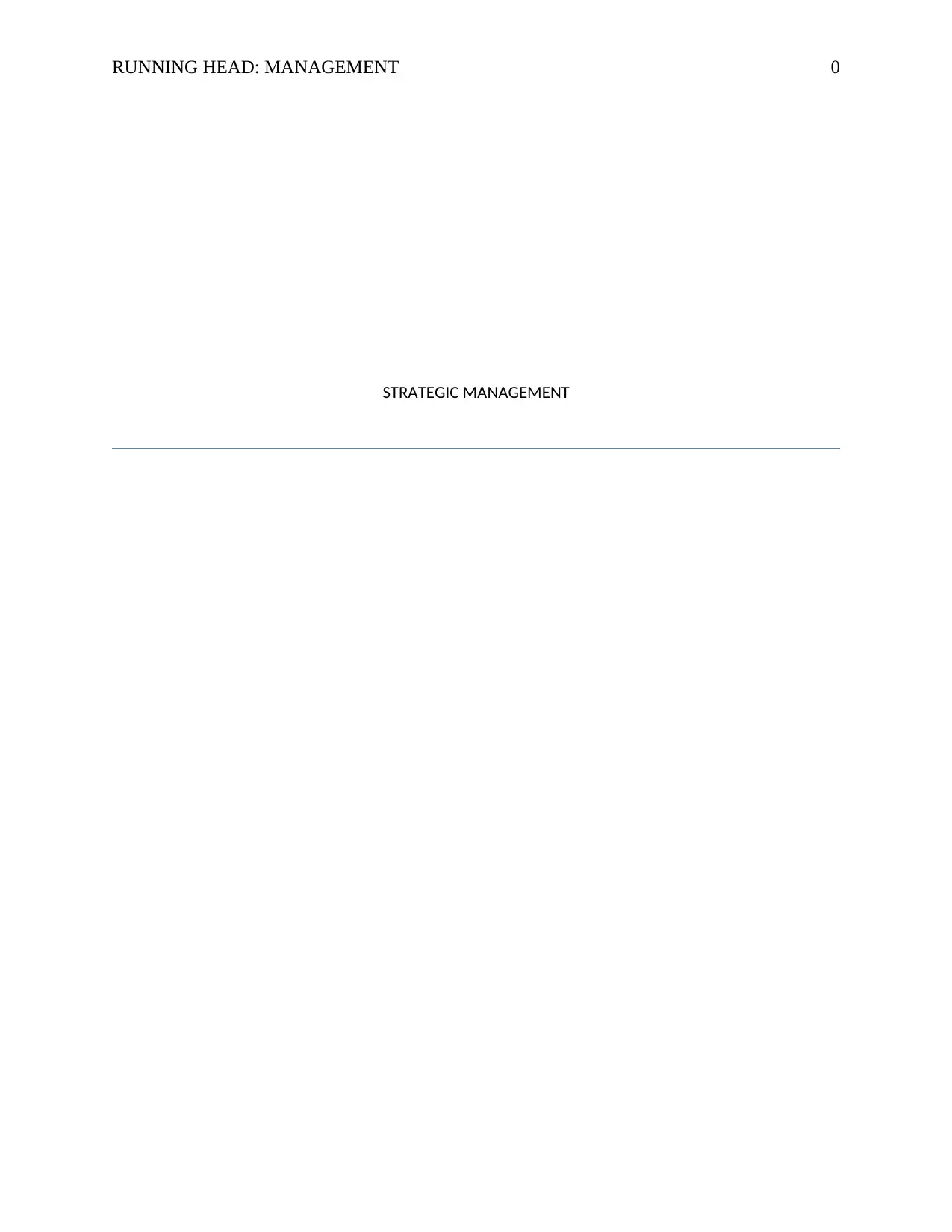
RUNNING HEAD: MANAGEMENT 0
STRATEGIC MANAGEMENT
STRATEGIC MANAGEMENT
Secure Best Marks with AI Grader
Need help grading? Try our AI Grader for instant feedback on your assignments.
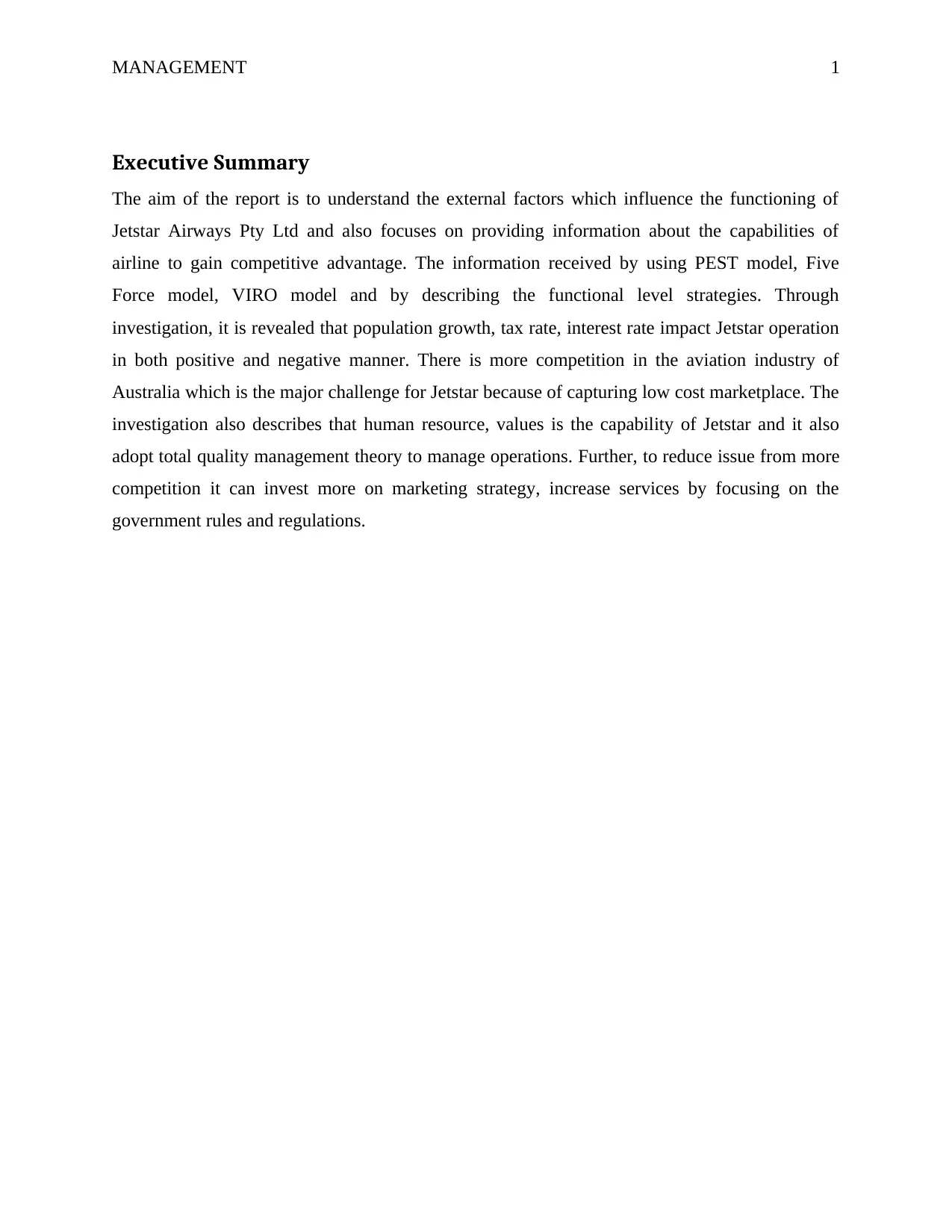
MANAGEMENT 1
Executive Summary
The aim of the report is to understand the external factors which influence the functioning of
Jetstar Airways Pty Ltd and also focuses on providing information about the capabilities of
airline to gain competitive advantage. The information received by using PEST model, Five
Force model, VIRO model and by describing the functional level strategies. Through
investigation, it is revealed that population growth, tax rate, interest rate impact Jetstar operation
in both positive and negative manner. There is more competition in the aviation industry of
Australia which is the major challenge for Jetstar because of capturing low cost marketplace. The
investigation also describes that human resource, values is the capability of Jetstar and it also
adopt total quality management theory to manage operations. Further, to reduce issue from more
competition it can invest more on marketing strategy, increase services by focusing on the
government rules and regulations.
Executive Summary
The aim of the report is to understand the external factors which influence the functioning of
Jetstar Airways Pty Ltd and also focuses on providing information about the capabilities of
airline to gain competitive advantage. The information received by using PEST model, Five
Force model, VIRO model and by describing the functional level strategies. Through
investigation, it is revealed that population growth, tax rate, interest rate impact Jetstar operation
in both positive and negative manner. There is more competition in the aviation industry of
Australia which is the major challenge for Jetstar because of capturing low cost marketplace. The
investigation also describes that human resource, values is the capability of Jetstar and it also
adopt total quality management theory to manage operations. Further, to reduce issue from more
competition it can invest more on marketing strategy, increase services by focusing on the
government rules and regulations.
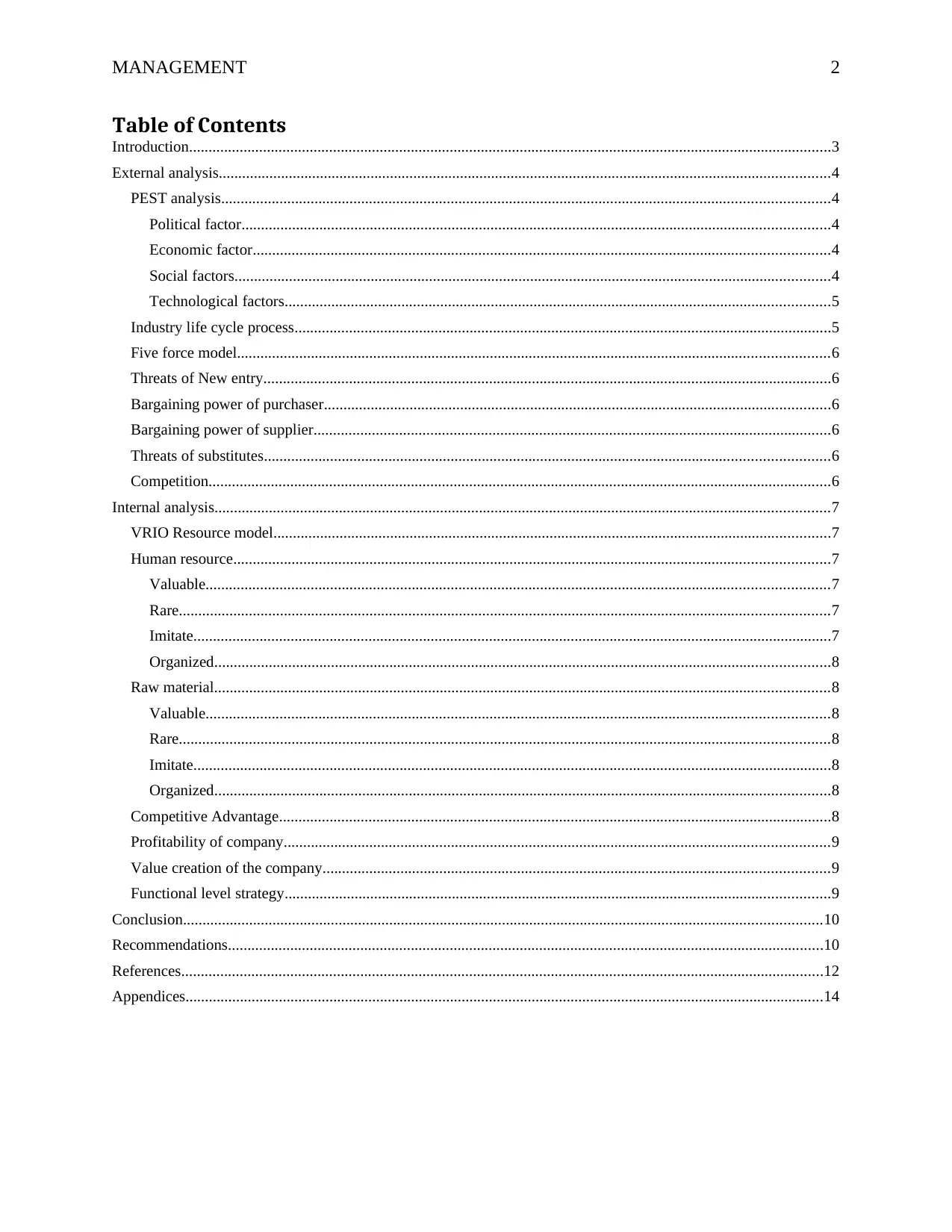
MANAGEMENT 2
Table of Contents
Introduction.....................................................................................................................................................................3
External analysis.............................................................................................................................................................4
PEST analysis............................................................................................................................................................4
Political factor.......................................................................................................................................................4
Economic factor....................................................................................................................................................4
Social factors.........................................................................................................................................................4
Technological factors............................................................................................................................................5
Industry life cycle process..........................................................................................................................................5
Five force model........................................................................................................................................................6
Threats of New entry..................................................................................................................................................6
Bargaining power of purchaser..................................................................................................................................6
Bargaining power of supplier.....................................................................................................................................6
Threats of substitutes.................................................................................................................................................6
Competition................................................................................................................................................................6
Internal analysis..............................................................................................................................................................7
VRIO Resource model...............................................................................................................................................7
Human resource.........................................................................................................................................................7
Valuable................................................................................................................................................................7
Rare.......................................................................................................................................................................7
Imitate....................................................................................................................................................................7
Organized..............................................................................................................................................................8
Raw material..............................................................................................................................................................8
Valuable................................................................................................................................................................8
Rare.......................................................................................................................................................................8
Imitate....................................................................................................................................................................8
Organized..............................................................................................................................................................8
Competitive Advantage..............................................................................................................................................8
Profitability of company............................................................................................................................................9
Value creation of the company..................................................................................................................................9
Functional level strategy............................................................................................................................................9
Conclusion....................................................................................................................................................................10
Recommendations.........................................................................................................................................................10
References.....................................................................................................................................................................12
Appendices....................................................................................................................................................................14
Table of Contents
Introduction.....................................................................................................................................................................3
External analysis.............................................................................................................................................................4
PEST analysis............................................................................................................................................................4
Political factor.......................................................................................................................................................4
Economic factor....................................................................................................................................................4
Social factors.........................................................................................................................................................4
Technological factors............................................................................................................................................5
Industry life cycle process..........................................................................................................................................5
Five force model........................................................................................................................................................6
Threats of New entry..................................................................................................................................................6
Bargaining power of purchaser..................................................................................................................................6
Bargaining power of supplier.....................................................................................................................................6
Threats of substitutes.................................................................................................................................................6
Competition................................................................................................................................................................6
Internal analysis..............................................................................................................................................................7
VRIO Resource model...............................................................................................................................................7
Human resource.........................................................................................................................................................7
Valuable................................................................................................................................................................7
Rare.......................................................................................................................................................................7
Imitate....................................................................................................................................................................7
Organized..............................................................................................................................................................8
Raw material..............................................................................................................................................................8
Valuable................................................................................................................................................................8
Rare.......................................................................................................................................................................8
Imitate....................................................................................................................................................................8
Organized..............................................................................................................................................................8
Competitive Advantage..............................................................................................................................................8
Profitability of company............................................................................................................................................9
Value creation of the company..................................................................................................................................9
Functional level strategy............................................................................................................................................9
Conclusion....................................................................................................................................................................10
Recommendations.........................................................................................................................................................10
References.....................................................................................................................................................................12
Appendices....................................................................................................................................................................14
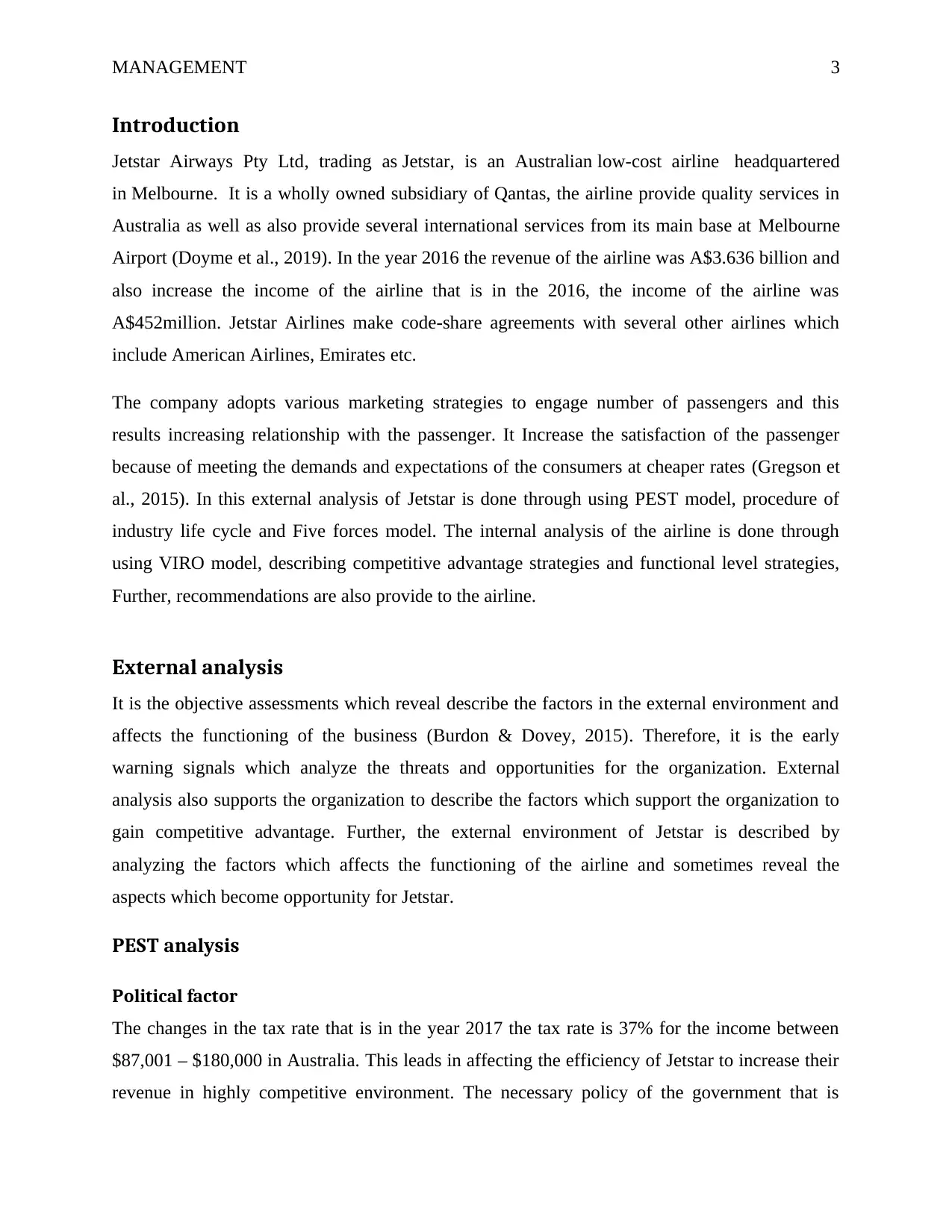
MANAGEMENT 3
Introduction
Jetstar Airways Pty Ltd, trading as Jetstar, is an Australian low-cost airline headquartered
in Melbourne. It is a wholly owned subsidiary of Qantas, the airline provide quality services in
Australia as well as also provide several international services from its main base at Melbourne
Airport (Doyme et al., 2019). In the year 2016 the revenue of the airline was A$3.636 billion and
also increase the income of the airline that is in the 2016, the income of the airline was
A$452million. Jetstar Airlines make code-share agreements with several other airlines which
include American Airlines, Emirates etc.
The company adopts various marketing strategies to engage number of passengers and this
results increasing relationship with the passenger. It Increase the satisfaction of the passenger
because of meeting the demands and expectations of the consumers at cheaper rates (Gregson et
al., 2015). In this external analysis of Jetstar is done through using PEST model, procedure of
industry life cycle and Five forces model. The internal analysis of the airline is done through
using VIRO model, describing competitive advantage strategies and functional level strategies,
Further, recommendations are also provide to the airline.
External analysis
It is the objective assessments which reveal describe the factors in the external environment and
affects the functioning of the business (Burdon & Dovey, 2015). Therefore, it is the early
warning signals which analyze the threats and opportunities for the organization. External
analysis also supports the organization to describe the factors which support the organization to
gain competitive advantage. Further, the external environment of Jetstar is described by
analyzing the factors which affects the functioning of the airline and sometimes reveal the
aspects which become opportunity for Jetstar.
PEST analysis
Political factor
The changes in the tax rate that is in the year 2017 the tax rate is 37% for the income between
$87,001 – $180,000 in Australia. This leads in affecting the efficiency of Jetstar to increase their
revenue in highly competitive environment. The necessary policy of the government that is
Introduction
Jetstar Airways Pty Ltd, trading as Jetstar, is an Australian low-cost airline headquartered
in Melbourne. It is a wholly owned subsidiary of Qantas, the airline provide quality services in
Australia as well as also provide several international services from its main base at Melbourne
Airport (Doyme et al., 2019). In the year 2016 the revenue of the airline was A$3.636 billion and
also increase the income of the airline that is in the 2016, the income of the airline was
A$452million. Jetstar Airlines make code-share agreements with several other airlines which
include American Airlines, Emirates etc.
The company adopts various marketing strategies to engage number of passengers and this
results increasing relationship with the passenger. It Increase the satisfaction of the passenger
because of meeting the demands and expectations of the consumers at cheaper rates (Gregson et
al., 2015). In this external analysis of Jetstar is done through using PEST model, procedure of
industry life cycle and Five forces model. The internal analysis of the airline is done through
using VIRO model, describing competitive advantage strategies and functional level strategies,
Further, recommendations are also provide to the airline.
External analysis
It is the objective assessments which reveal describe the factors in the external environment and
affects the functioning of the business (Burdon & Dovey, 2015). Therefore, it is the early
warning signals which analyze the threats and opportunities for the organization. External
analysis also supports the organization to describe the factors which support the organization to
gain competitive advantage. Further, the external environment of Jetstar is described by
analyzing the factors which affects the functioning of the airline and sometimes reveal the
aspects which become opportunity for Jetstar.
PEST analysis
Political factor
The changes in the tax rate that is in the year 2017 the tax rate is 37% for the income between
$87,001 – $180,000 in Australia. This leads in affecting the efficiency of Jetstar to increase their
revenue in highly competitive environment. The necessary policy of the government that is
Secure Best Marks with AI Grader
Need help grading? Try our AI Grader for instant feedback on your assignments.
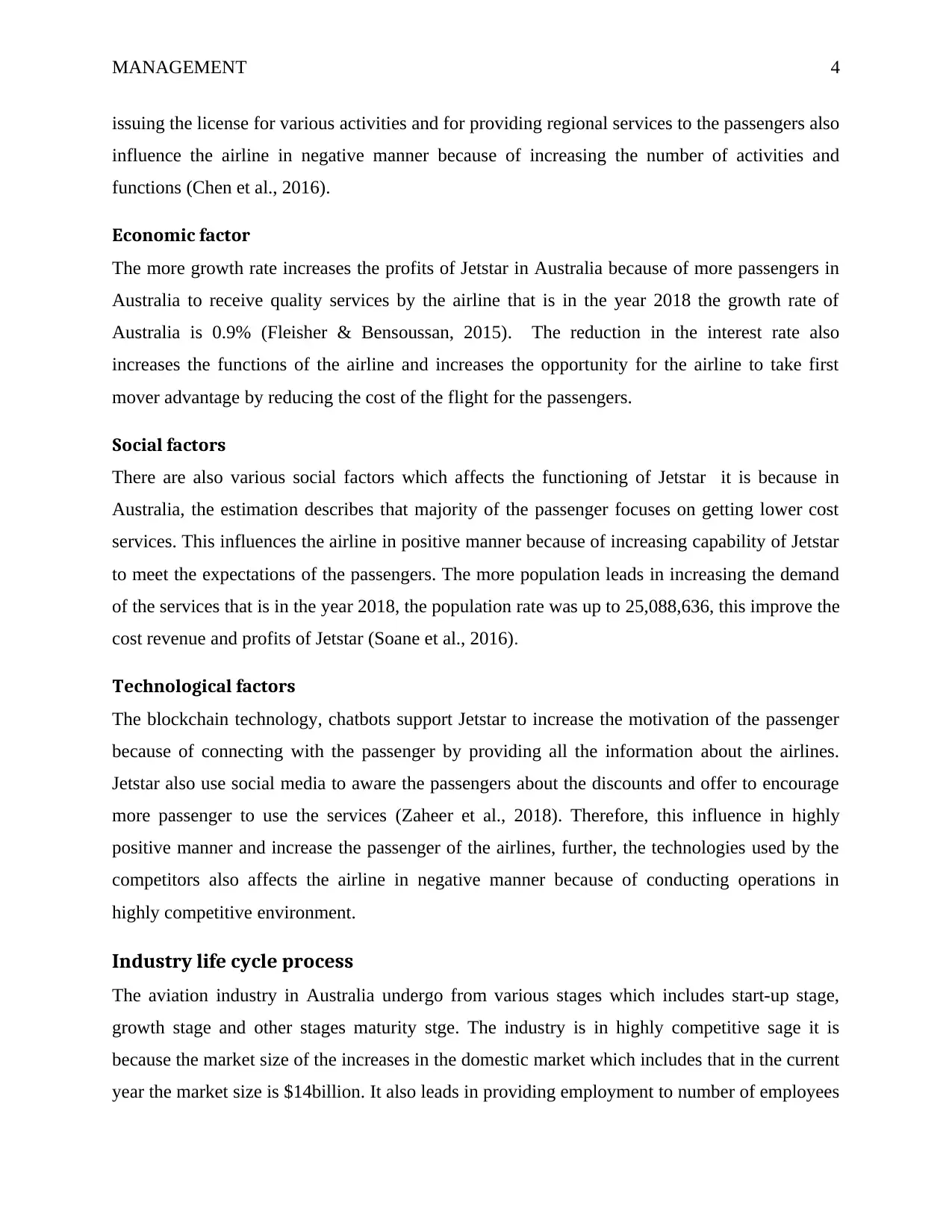
MANAGEMENT 4
issuing the license for various activities and for providing regional services to the passengers also
influence the airline in negative manner because of increasing the number of activities and
functions (Chen et al., 2016).
Economic factor
The more growth rate increases the profits of Jetstar in Australia because of more passengers in
Australia to receive quality services by the airline that is in the year 2018 the growth rate of
Australia is 0.9% (Fleisher & Bensoussan, 2015). The reduction in the interest rate also
increases the functions of the airline and increases the opportunity for the airline to take first
mover advantage by reducing the cost of the flight for the passengers.
Social factors
There are also various social factors which affects the functioning of Jetstar it is because in
Australia, the estimation describes that majority of the passenger focuses on getting lower cost
services. This influences the airline in positive manner because of increasing capability of Jetstar
to meet the expectations of the passengers. The more population leads in increasing the demand
of the services that is in the year 2018, the population rate was up to 25,088,636, this improve the
cost revenue and profits of Jetstar (Soane et al., 2016).
Technological factors
The blockchain technology, chatbots support Jetstar to increase the motivation of the passenger
because of connecting with the passenger by providing all the information about the airlines.
Jetstar also use social media to aware the passengers about the discounts and offer to encourage
more passenger to use the services (Zaheer et al., 2018). Therefore, this influence in highly
positive manner and increase the passenger of the airlines, further, the technologies used by the
competitors also affects the airline in negative manner because of conducting operations in
highly competitive environment.
Industry life cycle process
The aviation industry in Australia undergo from various stages which includes start-up stage,
growth stage and other stages maturity stge. The industry is in highly competitive sage it is
because the market size of the increases in the domestic market which includes that in the current
year the market size is $14billion. It also leads in providing employment to number of employees
issuing the license for various activities and for providing regional services to the passengers also
influence the airline in negative manner because of increasing the number of activities and
functions (Chen et al., 2016).
Economic factor
The more growth rate increases the profits of Jetstar in Australia because of more passengers in
Australia to receive quality services by the airline that is in the year 2018 the growth rate of
Australia is 0.9% (Fleisher & Bensoussan, 2015). The reduction in the interest rate also
increases the functions of the airline and increases the opportunity for the airline to take first
mover advantage by reducing the cost of the flight for the passengers.
Social factors
There are also various social factors which affects the functioning of Jetstar it is because in
Australia, the estimation describes that majority of the passenger focuses on getting lower cost
services. This influences the airline in positive manner because of increasing capability of Jetstar
to meet the expectations of the passengers. The more population leads in increasing the demand
of the services that is in the year 2018, the population rate was up to 25,088,636, this improve the
cost revenue and profits of Jetstar (Soane et al., 2016).
Technological factors
The blockchain technology, chatbots support Jetstar to increase the motivation of the passenger
because of connecting with the passenger by providing all the information about the airlines.
Jetstar also use social media to aware the passengers about the discounts and offer to encourage
more passenger to use the services (Zaheer et al., 2018). Therefore, this influence in highly
positive manner and increase the passenger of the airlines, further, the technologies used by the
competitors also affects the airline in negative manner because of conducting operations in
highly competitive environment.
Industry life cycle process
The aviation industry in Australia undergo from various stages which includes start-up stage,
growth stage and other stages maturity stge. The industry is in highly competitive sage it is
because the market size of the increases in the domestic market which includes that in the current
year the market size is $14billion. It also leads in providing employment to number of employees
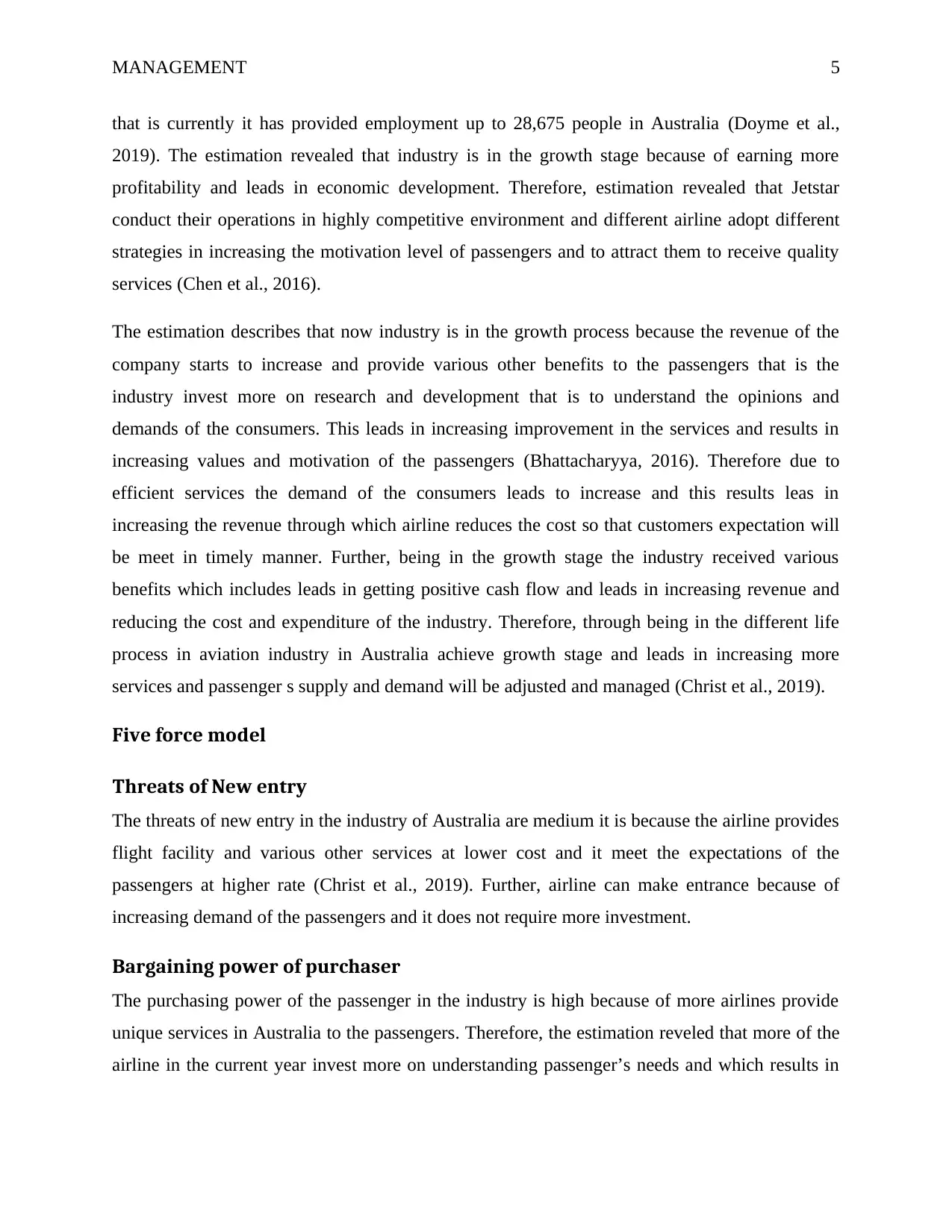
MANAGEMENT 5
that is currently it has provided employment up to 28,675 people in Australia (Doyme et al.,
2019). The estimation revealed that industry is in the growth stage because of earning more
profitability and leads in economic development. Therefore, estimation revealed that Jetstar
conduct their operations in highly competitive environment and different airline adopt different
strategies in increasing the motivation level of passengers and to attract them to receive quality
services (Chen et al., 2016).
The estimation describes that now industry is in the growth process because the revenue of the
company starts to increase and provide various other benefits to the passengers that is the
industry invest more on research and development that is to understand the opinions and
demands of the consumers. This leads in increasing improvement in the services and results in
increasing values and motivation of the passengers (Bhattacharyya, 2016). Therefore due to
efficient services the demand of the consumers leads to increase and this results leas in
increasing the revenue through which airline reduces the cost so that customers expectation will
be meet in timely manner. Further, being in the growth stage the industry received various
benefits which includes leads in getting positive cash flow and leads in increasing revenue and
reducing the cost and expenditure of the industry. Therefore, through being in the different life
process in aviation industry in Australia achieve growth stage and leads in increasing more
services and passenger s supply and demand will be adjusted and managed (Christ et al., 2019).
Five force model
Threats of New entry
The threats of new entry in the industry of Australia are medium it is because the airline provides
flight facility and various other services at lower cost and it meet the expectations of the
passengers at higher rate (Christ et al., 2019). Further, airline can make entrance because of
increasing demand of the passengers and it does not require more investment.
Bargaining power of purchaser
The purchasing power of the passenger in the industry is high because of more airlines provide
unique services in Australia to the passengers. Therefore, the estimation reveled that more of the
airline in the current year invest more on understanding passenger’s needs and which results in
that is currently it has provided employment up to 28,675 people in Australia (Doyme et al.,
2019). The estimation revealed that industry is in the growth stage because of earning more
profitability and leads in economic development. Therefore, estimation revealed that Jetstar
conduct their operations in highly competitive environment and different airline adopt different
strategies in increasing the motivation level of passengers and to attract them to receive quality
services (Chen et al., 2016).
The estimation describes that now industry is in the growth process because the revenue of the
company starts to increase and provide various other benefits to the passengers that is the
industry invest more on research and development that is to understand the opinions and
demands of the consumers. This leads in increasing improvement in the services and results in
increasing values and motivation of the passengers (Bhattacharyya, 2016). Therefore due to
efficient services the demand of the consumers leads to increase and this results leas in
increasing the revenue through which airline reduces the cost so that customers expectation will
be meet in timely manner. Further, being in the growth stage the industry received various
benefits which includes leads in getting positive cash flow and leads in increasing revenue and
reducing the cost and expenditure of the industry. Therefore, through being in the different life
process in aviation industry in Australia achieve growth stage and leads in increasing more
services and passenger s supply and demand will be adjusted and managed (Christ et al., 2019).
Five force model
Threats of New entry
The threats of new entry in the industry of Australia are medium it is because the airline provides
flight facility and various other services at lower cost and it meet the expectations of the
passengers at higher rate (Christ et al., 2019). Further, airline can make entrance because of
increasing demand of the passengers and it does not require more investment.
Bargaining power of purchaser
The purchasing power of the passenger in the industry is high because of more airlines provide
unique services in Australia to the passengers. Therefore, the estimation reveled that more of the
airline in the current year invest more on understanding passenger’s needs and which results in

MANAGEMENT 6
increasing the power of the buyers towards the services provided by airlines (Havinga et al.,
2018).
Bargaining power of supplier
The bargaining power of the suppliers is also high it is because of more airlines focuses on
attracting competent suppliers so that demand of the passengers will be meet in regular manner
at appropriate time period. Therefore, due to more number of competitors the power of supplier
is increased and raised to change the decision of the airline in favor of suppliers.
Threats of substitutes
The rate of substitution is medium it is because Jetstar provides more services and has the
opportunity to capture low-cost market in Australia. Therefore, estimation revealed that in the
current year it carry 8.5% passengers of Australia (Tretola, 2017). However, still various
opportunities arise in the external market through which competitor’s takes advantage to sustain
in long run.
Competition
The rate of competition is high in industry of Australia because of adopting different strategies
by the competitors of the airline which includes increasing marketing strategies in social media
technology. This leads in increasing engagement of the passengers towards the airline and
competitors also provide discount strategies.
Internal analysis
It is considered the approach in which individual explore the competency of the organization
trough which competitive position and capabilities of the company is revealed. It is the most
important model because it supports the organization to understand their strength and to gain
competitive advantage (Havinga et al., 2018). Through this company can also focuses on
describing the weaknesses so that policies are developed to overcome the issues and challenges.
increasing the power of the buyers towards the services provided by airlines (Havinga et al.,
2018).
Bargaining power of supplier
The bargaining power of the suppliers is also high it is because of more airlines focuses on
attracting competent suppliers so that demand of the passengers will be meet in regular manner
at appropriate time period. Therefore, due to more number of competitors the power of supplier
is increased and raised to change the decision of the airline in favor of suppliers.
Threats of substitutes
The rate of substitution is medium it is because Jetstar provides more services and has the
opportunity to capture low-cost market in Australia. Therefore, estimation revealed that in the
current year it carry 8.5% passengers of Australia (Tretola, 2017). However, still various
opportunities arise in the external market through which competitor’s takes advantage to sustain
in long run.
Competition
The rate of competition is high in industry of Australia because of adopting different strategies
by the competitors of the airline which includes increasing marketing strategies in social media
technology. This leads in increasing engagement of the passengers towards the airline and
competitors also provide discount strategies.
Internal analysis
It is considered the approach in which individual explore the competency of the organization
trough which competitive position and capabilities of the company is revealed. It is the most
important model because it supports the organization to understand their strength and to gain
competitive advantage (Havinga et al., 2018). Through this company can also focuses on
describing the weaknesses so that policies are developed to overcome the issues and challenges.
Paraphrase This Document
Need a fresh take? Get an instant paraphrase of this document with our AI Paraphraser
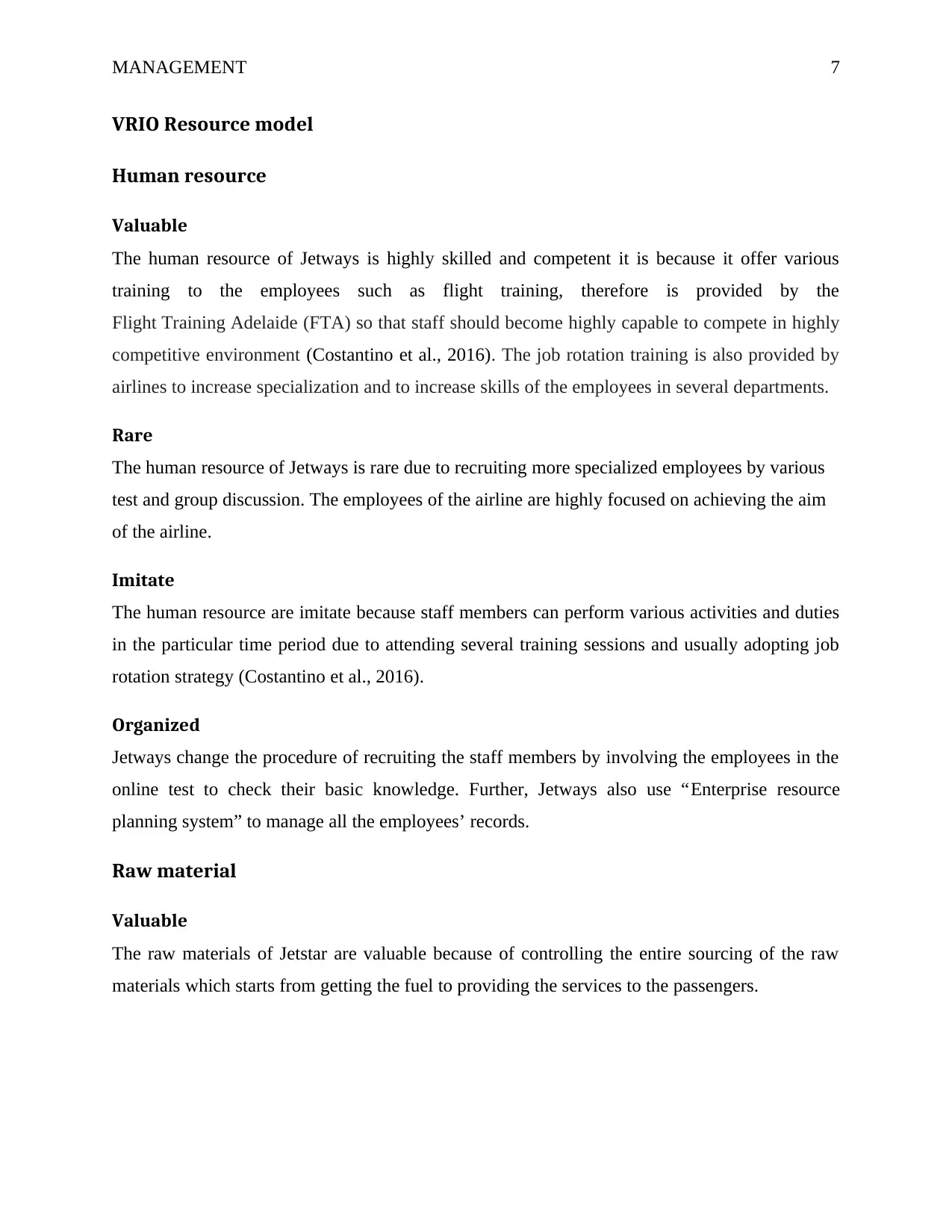
MANAGEMENT 7
VRIO Resource model
Human resource
Valuable
The human resource of Jetways is highly skilled and competent it is because it offer various
training to the employees such as flight training, therefore is provided by the
Flight Training Adelaide (FTA) so that staff should become highly capable to compete in highly
competitive environment (Costantino et al., 2016). The job rotation training is also provided by
airlines to increase specialization and to increase skills of the employees in several departments.
Rare
The human resource of Jetways is rare due to recruiting more specialized employees by various
test and group discussion. The employees of the airline are highly focused on achieving the aim
of the airline.
Imitate
The human resource are imitate because staff members can perform various activities and duties
in the particular time period due to attending several training sessions and usually adopting job
rotation strategy (Costantino et al., 2016).
Organized
Jetways change the procedure of recruiting the staff members by involving the employees in the
online test to check their basic knowledge. Further, Jetways also use “Enterprise resource
planning system” to manage all the employees’ records.
Raw material
Valuable
The raw materials of Jetstar are valuable because of controlling the entire sourcing of the raw
materials which starts from getting the fuel to providing the services to the passengers.
VRIO Resource model
Human resource
Valuable
The human resource of Jetways is highly skilled and competent it is because it offer various
training to the employees such as flight training, therefore is provided by the
Flight Training Adelaide (FTA) so that staff should become highly capable to compete in highly
competitive environment (Costantino et al., 2016). The job rotation training is also provided by
airlines to increase specialization and to increase skills of the employees in several departments.
Rare
The human resource of Jetways is rare due to recruiting more specialized employees by various
test and group discussion. The employees of the airline are highly focused on achieving the aim
of the airline.
Imitate
The human resource are imitate because staff members can perform various activities and duties
in the particular time period due to attending several training sessions and usually adopting job
rotation strategy (Costantino et al., 2016).
Organized
Jetways change the procedure of recruiting the staff members by involving the employees in the
online test to check their basic knowledge. Further, Jetways also use “Enterprise resource
planning system” to manage all the employees’ records.
Raw material
Valuable
The raw materials of Jetstar are valuable because of controlling the entire sourcing of the raw
materials which starts from getting the fuel to providing the services to the passengers.

MANAGEMENT 8
Rare
It is rare because of Jestar use some principles and pillar in developing the strategies for
providing raw materials and management of overall activity in which “deciding the source for
the future is one of the principle (Gregson et al., 2015).
Imitate
The raw material cannot be imitated because of using sustainable raw material to increase the
satisfaction of the passengers and providing the services in timely manner that is when need
arises.
Organized
The raw material of Jetways is managed through developing the structure and strategies that is
airline use SAP HANA software for effective operations management and to reduce challenges
in the airline so that cost will be reduced (Tretola, 2017).
Competitive Advantage
The unique services of Jetways support the airline to gain competitive advantage because the
estimation revealed that various challenges arise due to conduct their operations more
competition. The values and principles of Jetways support the airline to provide efficient services
by meeting the demands of the passengers that is “uniqueness”, “sincerity” as well as
“flexibility” (Maynard, 2017). It leads in providing distinctive services at lower cost this help the
airline to capture low cost market share. The marketing strategies that are it promote the airline
through using social media application which supports the airline to connect through more
passengers and aware about the new services as well as several discounts and offers regularly.
Profitability of company
The profitability of Airline is in the hands of the skilled employees, structure and capabilities of
airline, it is considered major core competencies of the airline. It is because this support in
understanding the requirements of the passengers and leads in increasing the profits and revenue
of airline. The estimation revealed that in the year 2019 the contribution made by the Jetstar was
up to $1.3 billion. Through, these strategies the airline is also recorded one of the “World’s safest
airline” and provide cheaper fare to the customers (Whyte & Lohmann, 2015).
Rare
It is rare because of Jestar use some principles and pillar in developing the strategies for
providing raw materials and management of overall activity in which “deciding the source for
the future is one of the principle (Gregson et al., 2015).
Imitate
The raw material cannot be imitated because of using sustainable raw material to increase the
satisfaction of the passengers and providing the services in timely manner that is when need
arises.
Organized
The raw material of Jetways is managed through developing the structure and strategies that is
airline use SAP HANA software for effective operations management and to reduce challenges
in the airline so that cost will be reduced (Tretola, 2017).
Competitive Advantage
The unique services of Jetways support the airline to gain competitive advantage because the
estimation revealed that various challenges arise due to conduct their operations more
competition. The values and principles of Jetways support the airline to provide efficient services
by meeting the demands of the passengers that is “uniqueness”, “sincerity” as well as
“flexibility” (Maynard, 2017). It leads in providing distinctive services at lower cost this help the
airline to capture low cost market share. The marketing strategies that are it promote the airline
through using social media application which supports the airline to connect through more
passengers and aware about the new services as well as several discounts and offers regularly.
Profitability of company
The profitability of Airline is in the hands of the skilled employees, structure and capabilities of
airline, it is considered major core competencies of the airline. It is because this support in
understanding the requirements of the passengers and leads in increasing the profits and revenue
of airline. The estimation revealed that in the year 2019 the contribution made by the Jetstar was
up to $1.3 billion. Through, these strategies the airline is also recorded one of the “World’s safest
airline” and provide cheaper fare to the customers (Whyte & Lohmann, 2015).
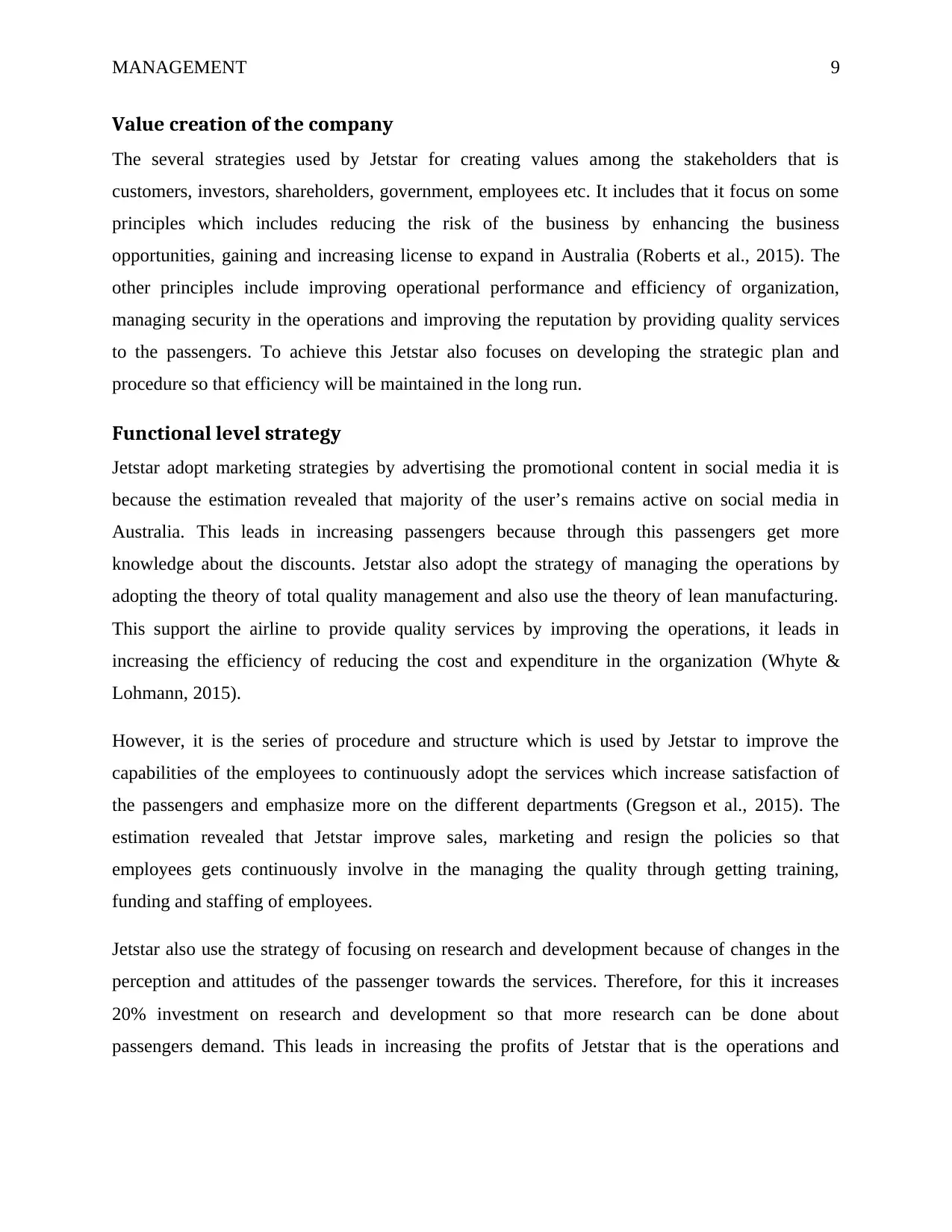
MANAGEMENT 9
Value creation of the company
The several strategies used by Jetstar for creating values among the stakeholders that is
customers, investors, shareholders, government, employees etc. It includes that it focus on some
principles which includes reducing the risk of the business by enhancing the business
opportunities, gaining and increasing license to expand in Australia (Roberts et al., 2015). The
other principles include improving operational performance and efficiency of organization,
managing security in the operations and improving the reputation by providing quality services
to the passengers. To achieve this Jetstar also focuses on developing the strategic plan and
procedure so that efficiency will be maintained in the long run.
Functional level strategy
Jetstar adopt marketing strategies by advertising the promotional content in social media it is
because the estimation revealed that majority of the user’s remains active on social media in
Australia. This leads in increasing passengers because through this passengers get more
knowledge about the discounts. Jetstar also adopt the strategy of managing the operations by
adopting the theory of total quality management and also use the theory of lean manufacturing.
This support the airline to provide quality services by improving the operations, it leads in
increasing the efficiency of reducing the cost and expenditure in the organization (Whyte &
Lohmann, 2015).
However, it is the series of procedure and structure which is used by Jetstar to improve the
capabilities of the employees to continuously adopt the services which increase satisfaction of
the passengers and emphasize more on the different departments (Gregson et al., 2015). The
estimation revealed that Jetstar improve sales, marketing and resign the policies so that
employees gets continuously involve in the managing the quality through getting training,
funding and staffing of employees.
Jetstar also use the strategy of focusing on research and development because of changes in the
perception and attitudes of the passenger towards the services. Therefore, for this it increases
20% investment on research and development so that more research can be done about
passengers demand. This leads in increasing the profits of Jetstar that is the operations and
Value creation of the company
The several strategies used by Jetstar for creating values among the stakeholders that is
customers, investors, shareholders, government, employees etc. It includes that it focus on some
principles which includes reducing the risk of the business by enhancing the business
opportunities, gaining and increasing license to expand in Australia (Roberts et al., 2015). The
other principles include improving operational performance and efficiency of organization,
managing security in the operations and improving the reputation by providing quality services
to the passengers. To achieve this Jetstar also focuses on developing the strategic plan and
procedure so that efficiency will be maintained in the long run.
Functional level strategy
Jetstar adopt marketing strategies by advertising the promotional content in social media it is
because the estimation revealed that majority of the user’s remains active on social media in
Australia. This leads in increasing passengers because through this passengers get more
knowledge about the discounts. Jetstar also adopt the strategy of managing the operations by
adopting the theory of total quality management and also use the theory of lean manufacturing.
This support the airline to provide quality services by improving the operations, it leads in
increasing the efficiency of reducing the cost and expenditure in the organization (Whyte &
Lohmann, 2015).
However, it is the series of procedure and structure which is used by Jetstar to improve the
capabilities of the employees to continuously adopt the services which increase satisfaction of
the passengers and emphasize more on the different departments (Gregson et al., 2015). The
estimation revealed that Jetstar improve sales, marketing and resign the policies so that
employees gets continuously involve in the managing the quality through getting training,
funding and staffing of employees.
Jetstar also use the strategy of focusing on research and development because of changes in the
perception and attitudes of the passenger towards the services. Therefore, for this it increases
20% investment on research and development so that more research can be done about
passengers demand. This leads in increasing the profits of Jetstar that is the operations and
Secure Best Marks with AI Grader
Need help grading? Try our AI Grader for instant feedback on your assignments.
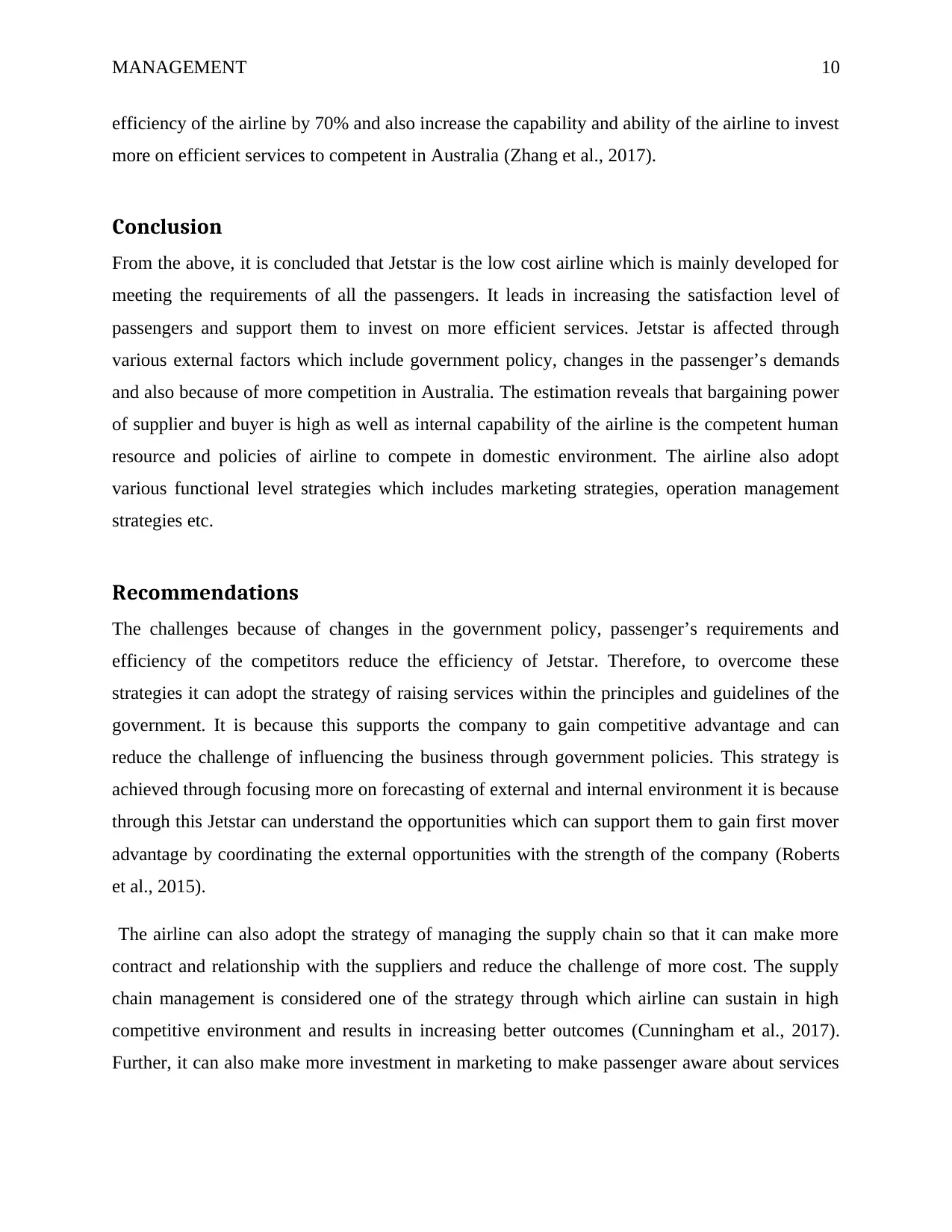
MANAGEMENT 10
efficiency of the airline by 70% and also increase the capability and ability of the airline to invest
more on efficient services to competent in Australia (Zhang et al., 2017).
Conclusion
From the above, it is concluded that Jetstar is the low cost airline which is mainly developed for
meeting the requirements of all the passengers. It leads in increasing the satisfaction level of
passengers and support them to invest on more efficient services. Jetstar is affected through
various external factors which include government policy, changes in the passenger’s demands
and also because of more competition in Australia. The estimation reveals that bargaining power
of supplier and buyer is high as well as internal capability of the airline is the competent human
resource and policies of airline to compete in domestic environment. The airline also adopt
various functional level strategies which includes marketing strategies, operation management
strategies etc.
Recommendations
The challenges because of changes in the government policy, passenger’s requirements and
efficiency of the competitors reduce the efficiency of Jetstar. Therefore, to overcome these
strategies it can adopt the strategy of raising services within the principles and guidelines of the
government. It is because this supports the company to gain competitive advantage and can
reduce the challenge of influencing the business through government policies. This strategy is
achieved through focusing more on forecasting of external and internal environment it is because
through this Jetstar can understand the opportunities which can support them to gain first mover
advantage by coordinating the external opportunities with the strength of the company (Roberts
et al., 2015).
The airline can also adopt the strategy of managing the supply chain so that it can make more
contract and relationship with the suppliers and reduce the challenge of more cost. The supply
chain management is considered one of the strategy through which airline can sustain in high
competitive environment and results in increasing better outcomes (Cunningham et al., 2017).
Further, it can also make more investment in marketing to make passenger aware about services
efficiency of the airline by 70% and also increase the capability and ability of the airline to invest
more on efficient services to competent in Australia (Zhang et al., 2017).
Conclusion
From the above, it is concluded that Jetstar is the low cost airline which is mainly developed for
meeting the requirements of all the passengers. It leads in increasing the satisfaction level of
passengers and support them to invest on more efficient services. Jetstar is affected through
various external factors which include government policy, changes in the passenger’s demands
and also because of more competition in Australia. The estimation reveals that bargaining power
of supplier and buyer is high as well as internal capability of the airline is the competent human
resource and policies of airline to compete in domestic environment. The airline also adopt
various functional level strategies which includes marketing strategies, operation management
strategies etc.
Recommendations
The challenges because of changes in the government policy, passenger’s requirements and
efficiency of the competitors reduce the efficiency of Jetstar. Therefore, to overcome these
strategies it can adopt the strategy of raising services within the principles and guidelines of the
government. It is because this supports the company to gain competitive advantage and can
reduce the challenge of influencing the business through government policies. This strategy is
achieved through focusing more on forecasting of external and internal environment it is because
through this Jetstar can understand the opportunities which can support them to gain first mover
advantage by coordinating the external opportunities with the strength of the company (Roberts
et al., 2015).
The airline can also adopt the strategy of managing the supply chain so that it can make more
contract and relationship with the suppliers and reduce the challenge of more cost. The supply
chain management is considered one of the strategy through which airline can sustain in high
competitive environment and results in increasing better outcomes (Cunningham et al., 2017).
Further, it can also make more investment in marketing to make passenger aware about services

MANAGEMENT 11
by providing promotional messages to the passengers this also results in developing relations
with the clients.
References
by providing promotional messages to the passengers this also results in developing relations
with the clients.
References
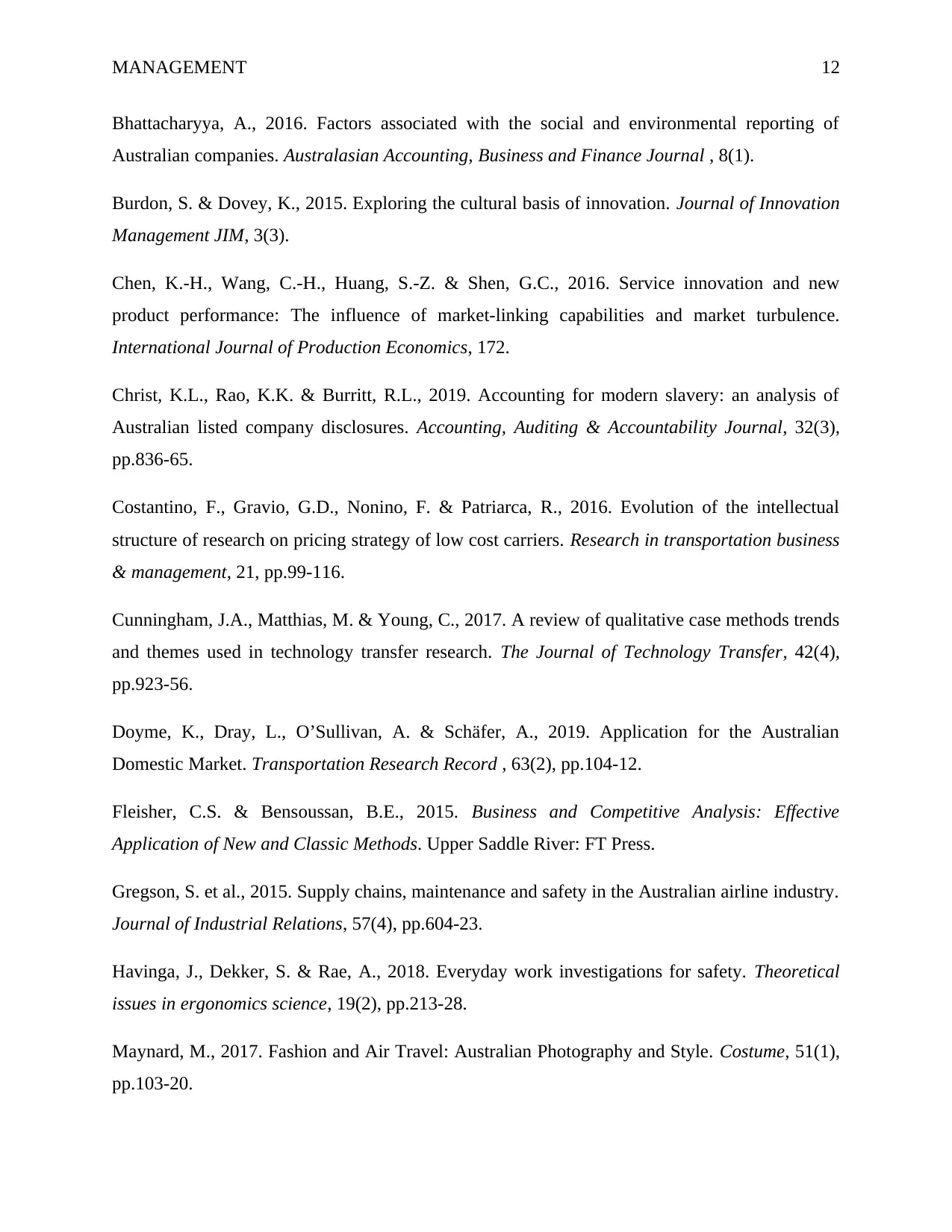
MANAGEMENT 12
Bhattacharyya, A., 2016. Factors associated with the social and environmental reporting of
Australian companies. Australasian Accounting, Business and Finance Journal , 8(1).
Burdon, S. & Dovey, K., 2015. Exploring the cultural basis of innovation. Journal of Innovation
Management JIM, 3(3).
Chen, K.-H., Wang, C.-H., Huang, S.-Z. & Shen, G.C., 2016. Service innovation and new
product performance: The influence of market-linking capabilities and market turbulence.
International Journal of Production Economics, 172.
Christ, K.L., Rao, K.K. & Burritt, R.L., 2019. Accounting for modern slavery: an analysis of
Australian listed company disclosures. Accounting, Auditing & Accountability Journal, 32(3),
pp.836-65.
Costantino, F., Gravio, G.D., Nonino, F. & Patriarca, R., 2016. Evolution of the intellectual
structure of research on pricing strategy of low cost carriers. Research in transportation business
& management, 21, pp.99-116.
Cunningham, J.A., Matthias, M. & Young, C., 2017. A review of qualitative case methods trends
and themes used in technology transfer research. The Journal of Technology Transfer, 42(4),
pp.923-56.
Doyme, K., Dray, L., O’Sullivan, A. & Schäfer, A., 2019. Application for the Australian
Domestic Market. Transportation Research Record , 63(2), pp.104-12.
Fleisher, C.S. & Bensoussan, B.E., 2015. Business and Competitive Analysis: Effective
Application of New and Classic Methods. Upper Saddle River: FT Press.
Gregson, S. et al., 2015. Supply chains, maintenance and safety in the Australian airline industry.
Journal of Industrial Relations, 57(4), pp.604-23.
Havinga, J., Dekker, S. & Rae, A., 2018. Everyday work investigations for safety. Theoretical
issues in ergonomics science, 19(2), pp.213-28.
Maynard, M., 2017. Fashion and Air Travel: Australian Photography and Style. Costume, 51(1),
pp.103-20.
Bhattacharyya, A., 2016. Factors associated with the social and environmental reporting of
Australian companies. Australasian Accounting, Business and Finance Journal , 8(1).
Burdon, S. & Dovey, K., 2015. Exploring the cultural basis of innovation. Journal of Innovation
Management JIM, 3(3).
Chen, K.-H., Wang, C.-H., Huang, S.-Z. & Shen, G.C., 2016. Service innovation and new
product performance: The influence of market-linking capabilities and market turbulence.
International Journal of Production Economics, 172.
Christ, K.L., Rao, K.K. & Burritt, R.L., 2019. Accounting for modern slavery: an analysis of
Australian listed company disclosures. Accounting, Auditing & Accountability Journal, 32(3),
pp.836-65.
Costantino, F., Gravio, G.D., Nonino, F. & Patriarca, R., 2016. Evolution of the intellectual
structure of research on pricing strategy of low cost carriers. Research in transportation business
& management, 21, pp.99-116.
Cunningham, J.A., Matthias, M. & Young, C., 2017. A review of qualitative case methods trends
and themes used in technology transfer research. The Journal of Technology Transfer, 42(4),
pp.923-56.
Doyme, K., Dray, L., O’Sullivan, A. & Schäfer, A., 2019. Application for the Australian
Domestic Market. Transportation Research Record , 63(2), pp.104-12.
Fleisher, C.S. & Bensoussan, B.E., 2015. Business and Competitive Analysis: Effective
Application of New and Classic Methods. Upper Saddle River: FT Press.
Gregson, S. et al., 2015. Supply chains, maintenance and safety in the Australian airline industry.
Journal of Industrial Relations, 57(4), pp.604-23.
Havinga, J., Dekker, S. & Rae, A., 2018. Everyday work investigations for safety. Theoretical
issues in ergonomics science, 19(2), pp.213-28.
Maynard, M., 2017. Fashion and Air Travel: Australian Photography and Style. Costume, 51(1),
pp.103-20.
Paraphrase This Document
Need a fresh take? Get an instant paraphrase of this document with our AI Paraphraser

MANAGEMENT 13
Roberts, J., Danaher, P., Roberts, K. & Simpson, A., 2015. Jetstar Airways: How Modeling
Guided the Brand Migration Strategy of a Low-Cost Carrie. GfK Marketing Intelligence Review,
4(2), pp.42-51.
Soane, E. et al., 2016. Confluence and Contours: Reflexive Management of Environmental Risk.
Risk Anlaysis, 36(6).
Statista, 2019. Population growth in Australia 2018. [Online] Available at:
https://www.statista.com/statistics/260472/population-growth-in-australia/.
Tretola, J., 2017. Comparing the New Zealand and Australian GAAR. Revenue Law Journal,
25(1), pp.35-44.
Whyte, R. & Lohmann, G., 2015. The carrier-within-a-carrier strategy: An analysis of Jetstar.
Journal of Air Transport Management, 42, pp.141-48.
Zaheer, H., Breyer, Y., Dumay, J. & Enjeti, M., 2018. Straight from the horse's mouth: Founders'
perspectives on achieving ‘traction’ in digital start-ups. Computers in Human Behavior.
Zhang, Y., Wang, K. & Fu, X., 2017. Air transport services in regional Australia: Demand
pattern, frequency choice and airport entry. Transportation Research Part A: Policy and
Practice, 103, pp.472-89.
Roberts, J., Danaher, P., Roberts, K. & Simpson, A., 2015. Jetstar Airways: How Modeling
Guided the Brand Migration Strategy of a Low-Cost Carrie. GfK Marketing Intelligence Review,
4(2), pp.42-51.
Soane, E. et al., 2016. Confluence and Contours: Reflexive Management of Environmental Risk.
Risk Anlaysis, 36(6).
Statista, 2019. Population growth in Australia 2018. [Online] Available at:
https://www.statista.com/statistics/260472/population-growth-in-australia/.
Tretola, J., 2017. Comparing the New Zealand and Australian GAAR. Revenue Law Journal,
25(1), pp.35-44.
Whyte, R. & Lohmann, G., 2015. The carrier-within-a-carrier strategy: An analysis of Jetstar.
Journal of Air Transport Management, 42, pp.141-48.
Zaheer, H., Breyer, Y., Dumay, J. & Enjeti, M., 2018. Straight from the horse's mouth: Founders'
perspectives on achieving ‘traction’ in digital start-ups. Computers in Human Behavior.
Zhang, Y., Wang, K. & Fu, X., 2017. Air transport services in regional Australia: Demand
pattern, frequency choice and airport entry. Transportation Research Part A: Policy and
Practice, 103, pp.472-89.
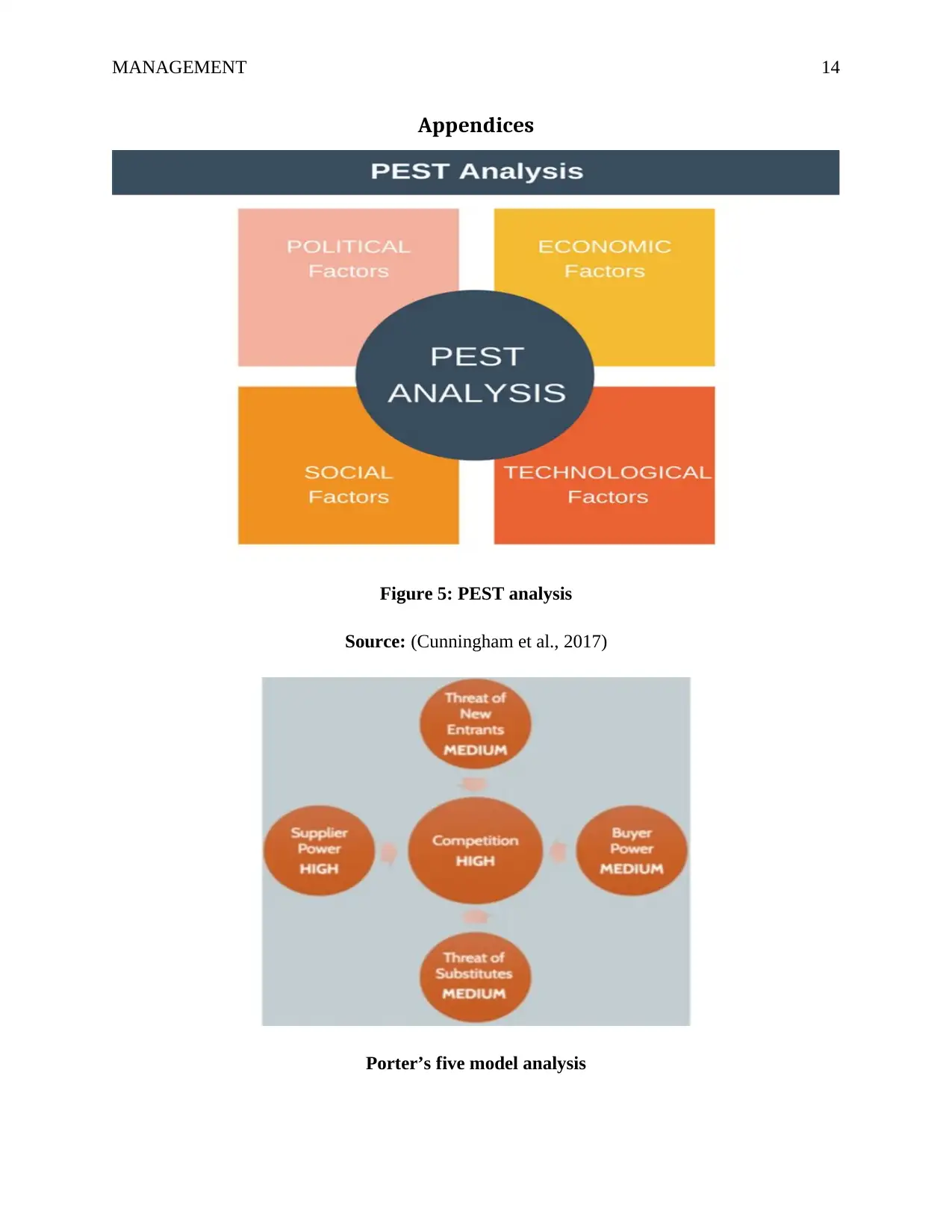
MANAGEMENT 14
Appendices
Figure 5: PEST analysis
Source: (Cunningham et al., 2017)
Porter’s five model analysis
Appendices
Figure 5: PEST analysis
Source: (Cunningham et al., 2017)
Porter’s five model analysis

MANAGEMENT 15
SOURCE: (Havinga et al., 2018)
Population growth
SOURCE: (Statista, 2019)
Tax Rate of Australia
SOURCE: (Doyme et al., 2019)
SOURCE: (Havinga et al., 2018)
Population growth
SOURCE: (Statista, 2019)
Tax Rate of Australia
SOURCE: (Doyme et al., 2019)
Secure Best Marks with AI Grader
Need help grading? Try our AI Grader for instant feedback on your assignments.

MANAGEMENT 16
1 out of 17
Related Documents
Your All-in-One AI-Powered Toolkit for Academic Success.
+13062052269
info@desklib.com
Available 24*7 on WhatsApp / Email
![[object Object]](/_next/static/media/star-bottom.7253800d.svg)
Unlock your academic potential
© 2024 | Zucol Services PVT LTD | All rights reserved.





